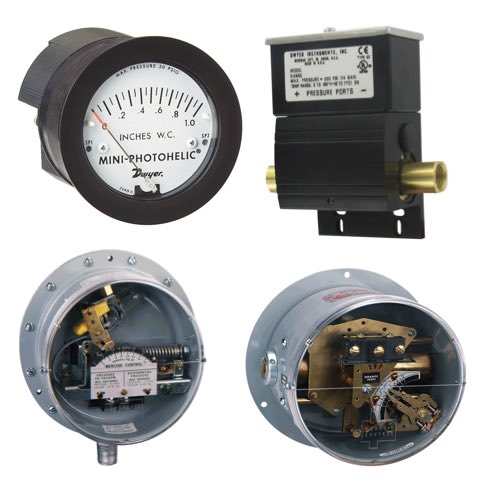Pressure Switches

Pressure switches are essential components that monitor and control pressure levels in a variety of industrial and commercial applications. They can be either a mechanical or electronic device. Each type serves specific needs depending on the sorts of pressure they're tasked to handle, the process fluid, and the environment in which they're placed. Mechanical pressure switches usually control straightforward pressure applications. If your equipment isn't trying to do something very complicated with its pressure control, mechanical pressure switches should have you covered. Conversely, if you do have a complicated application, these switches likely have some manner of digital output that communicates what they're doing.
Pressure switches are available in many forms, low-pressure switches for more sensitive systems and the high-pressure switches for tougher applications. And then there are the adjustable pressure switches, which let you set the pressure threshold to whatever fits your particular application. If those applications happen to be in hazardous or explosive environments, then you would use an explosion-proof switch. Other pressure switches include: electronic pressure switches, mechanical pressure switches, differential pressure switches, hydraulic pressure switches, diaphragm pressure switches, oil pressure switches, air pressure switches and gas pressure switches.
More Information about Pressure Switches
Durability and dependability define oil pressure and industrial pressure switches. These devices are built to perform in tough environments, where high temperature and corrosive substances test their mettle. Yet how do they manage to avert malfunctions and fulfill the mission of reliable and robust pressure control? Usually, it’s with the incorporation of a pressure sensing component or element that detects the vital sign of fluid pressure and activates the switch when the set point is reached. Switches of this kind are selected based on a number of criteria, the kind of operational and environmental parameters that would do in any lesser device. These must handle air, oil, or hydraulic pressure if they’re to maintain system integrity, safeguard against damage and disasters, and confer effective pressure control in a variety of applications.
FAQs
What is a pressure switch and how does it work?
A pressure switch is a device that monitors system pressure and opens or closes an electrical contact when a preset pressure level is reached. Unlike pressure sensors or transmitters that provide continuous measurement, pressure switches are designed for on/off control, alarms, or safety interlocks. They are commonly used to start or stop pumps, trigger alarms, or protect equipment from overpressure or loss of pressure.
What are pressure switches commonly used for?
Pressure switches are widely used for equipment protection, process control, and automation safety in applications such as pumps, compressors, hydraulic systems, pneumatic systems, HVAC equipment, and industrial machinery. They help prevent damage by shutting down systems or activating alarms when pressure moves outside acceptable limits. Their simplicity and reliability make them ideal for control and safety functions.
What types of pressure switches are available?
Pressure switches are available in mechanical and electronic designs, with options for adjustable or fixed setpoints. Common types include differential pressure switches, vacuum pressure switches, low-pressure switches, and high-pressure switches. Selecting the right pressure switch depends on pressure range, media compatibility, electrical rating, environmental conditions, and whether the application requires precise adjustment or basic control.
How do I choose the right pressure switch for my application?
Choosing the correct pressure switch involves evaluating operating pressure range, setpoint accuracy, system media, temperature, electrical load, and installation environment. Additional considerations include hysteresis (deadband), enclosure rating, and certifications required for safety or hazardous locations. Proper selection ensures reliable switching, longer service life, and protection of connected equipment.
Do pressure switches require calibration or maintenance?
Yes, pressure switches should be periodically inspected and tested to ensure they activate at the correct pressure setpoints. Calibration frequency depends on application criticality, operating conditions, and industry standards. Routine maintenance helps identify switch drift, mechanical wear, or pressure sensing issues early, ensuring dependable system control and safety.

